Improving Soil Moisture Estimation by Identification of NDVI Thresholds Optimization: An Application to the Chinese Loess Plateau
Abstract
1. Introduction
2. Study Area and Data
2.1. Study Area
2.2. Satellite Data and Image Pre-Processing
2.3. In Situ Observation Data
3. Principles and Methods
3.1. Subregional RSM Estimation
3.1.1. Apparent Thermal Inertia (ATI)
3.1.2. Temperature Vegetation Dryness Index (TVDI)
3.1.3. RSM Estimation with Criterion 2
3.2. Comparison of the Two Criteria
3.2.1. Calibration and Validation Processes for the Two Criteria
3.2.2. Evaluation of Estimated RSM for the Two Criteria
4. Results and Discussion
4.1. Evaluation of the Optimal NDVI Thresholds
4.1.1. Comparison of Validation Results
4.1.2. The Optimal NDVI Thresholds
4.2. Comparison of Estimated RSM
4.2.1. Evaluation of Estimated RSM at the Regional Scale
4.2.2. Evaluation of Estimated RSM at the Station Scale
4.3. Evaluation of Estimated RSM with Criterion 2
4.3.1. Estimated Monthly RSM
4.3.2. Estimated Seasonal and Yearly RSM
5. Conclusions
- The ATI/TVDI joint models not only have higher applicability than the ATI-based and TVDI-based models for all 8-day periods but also for simultaneous use within different NDVI ranges in the ATI/TVDI subregions for one 8-day period. Thus, in addition to the optimal NDVI thresholds, the additional NDVI thresholds we applied was another improved strategy to acquire wider spatial coverage of RSM estimation.
- NDVI thresholds were optimized for robust RSM estimation with Criterion 2 for each 8-day period over the CLP and the selected optimal thresholds constantly changed throughout the study period. The applicability of Criterion 2, involving spatiotemporal coverage (45 and 38 8-day periods of RSM maps and the total RSM area of 939.52 × 104 km2 and 667.44 × 104 km2 with Criterion 2 and Criterion 1, respectively) and the accuracy (maximum of 0.82 ± 0.007 for Criterion 2 and of 0.75 ± 0.008 for Criterion 1) of estimated RSM, was better than that of Criterion 1.
- The estimated RSM (closer to the observation) with Criterion 2 kept a better trend with the observed RSM at the station scale. Moreover, more estimated RSM with Criterion 2 was observed than with Criterion 1 throughout the period.
- High estimated RSM was observed in the periods when there were records of rainfall events, especially in autumn (mean RSM of 13.91 ± 2.65%)—wetter than other seasons. With a mean annual RSM of 10.16 ± 2.21%, the annual RSM map shows dryer areas in the southeastern part of the CLP.
Author Contributions
Funding
Institutional Review Board Statement
Informed Consent Statement
Data Availability Statement
Acknowledgments
Conflicts of Interest
References
- Kumar, S.V.; Dirmeyer, P.A.; Peters-Lidard, C.D.; Bindlish, R.; Bolten, J. Information Theoretic Evaluation of Satellite Soil Moisture Retrievals. Remote Sens. Environ. 2018, 204, 392–400. [Google Scholar] [CrossRef]
- Li, Z.; Lin, X.; Coles, A.E.; Chen, X. Catchment-Scale Surface Water-Groundwater Connectivity on China’s Loess Plateau. Catena 2017, 152, 268–276. [Google Scholar] [CrossRef]
- Hou, J.; Zhu, H.; Fu, B.; Lu, Y.; Zhou, J. Functional Traits Explain Seasonal Variation Effects of Plant Communities on Soil Erosion in Semiarid Grasslands in the Loess Plateau of China. Catena 2020, 194, 104743. [Google Scholar] [CrossRef]
- Zhao, J.; Van Oost, K.; Chen, L.; Govers, G. Moderate Topsoil Erosion Rates Constrain the Magnitude of the Erosion-Induced Carbon Sink and Agricultural Productivity Losses on the Chinese Loess Plateau. Biogeosciences 2016, 13, 4735–4750. [Google Scholar] [CrossRef]
- Djamai, N.; Magagi, R.; Goïta, K.; Merlin, O.; Kerr, Y.; Roy, A. A Combination of DISPATCH Downscaling Algorithm with CLASS Land Surface Scheme for Soil Moisture Estimation at Fine Scale during Cloudy Days. Remote Sens. Environ. 2016, 184, 1–14. [Google Scholar] [CrossRef]
- Hardy, A.J.; Barr, S.L.; Mills, J.P.; Miller, P.E. Characterising Soil Moisture in Transport Corridor Environments Using Airborne LIDAR and CASI data. Hydrol. Process. 2011, 26, 1925–1936. [Google Scholar] [CrossRef]
- Yee, M.S.; Walker, J.P.; Rüdiger, C.; Parinussa, R.M.; Koike, T.; Kerr, Y.H. A Comparison of SMOS and AMSR2 Soil Moisture Using Representative Sites of the OzNet Monitoring Network. Remote Sens. Environ. 2017, 195, 297–312. [Google Scholar] [CrossRef]
- Zawadzki, J.; Kedzior, M. Soil Moisture Variability over Odra Watershed: Comparison between SMOS and GLDAS Data. Int. J. Appl. Earth Obs. Geoinf. 2016, 45, 110–124. [Google Scholar] [CrossRef]
- Ebrahimi-Khusfi, M.; Alavipanah, S.K.; Hamzeh, S.; Amiraslani, F.; Samany, N.N.; Wigneron, J.-P. Comparison of Soil Moisture Retrieval Algorithms Based on the Synergy Between SMAP and SMOS-IC. Int. J. Appl. Earth Obs. Geoinf. 2018, 67, 148–160. [Google Scholar] [CrossRef]
- Escorihuela, M.J.; Quintana-Seguí, P. Comparison of Remote Sensing and Simulated Soil Moisture Datasets in Mediterranean Landscapes. Remote Sens. Environ. 2016, 180, 99–114. [Google Scholar] [CrossRef]
- Pardé, M.; Wigneron, J.-P.; Chanzy, A.; Waldteufel, P.; Kerr, Y.; Huet, S. Retrieving Surface Soil Moisture over a Wheat Field: Comparison of Different Methods. Remote Sens. Environ. 2003, 87, 334–344. [Google Scholar] [CrossRef]
- Holgate, C.M.; De Jeu, R.; Van Dijk, A.; Liu, Y.; Renzullo, L.; Vinodkumar; Dharssi, I.; Parinussa, R.; Van Der Schalie, R.; Gevaert, A.; et al. Comparison of Remotely Sensed and Modelled Soil Moisture Data Sets across Australia. Remote Sens. Environ. 2016, 186, 479–500. [Google Scholar] [CrossRef]
- Agutu, N.; Awange, J.; Zerihun, A.; Ndehedehe, C.; Kuhn, M.; Fukuda, Y. Assessing Multi-Satellite Remote Sensing, Reanalysis, and Land Surface Models’ Products in Characterizing Agricultural Drought in East Africa. Remote Sens. Environ. 2017, 194, 287–302. [Google Scholar] [CrossRef]
- Hu, T.; Van Dijk, A.I.; Renzullo, L.J.; Xu, Z.; He, J.; Tian, S.; Zhou, J.; Li, H. On Agricultural Drought Monitoring in Australia Using Himawari-8 Geostationary Thermal Infrared Observations. Int. J. Appl. Earth Obs. Geoinf. 2020, 91, 102153. [Google Scholar] [CrossRef]
- Yu, Y.; Wang, J.; Cheng, F.; Chen, Y. Soil Moisture by Remote Sensing Retrieval in the Tropic of Cancer of Yunnan Province. Pol. J. Environ. Stud. 2020, 29, 1981–1993. [Google Scholar] [CrossRef]
- Amani, M.; Salehi, B.; Mahdavi, S.; Masjedi, A.; Dehnavi, S. Temperature-Vegetation-soil Moisture Dryness Index (TVMDI). Remote Sens. Environ. 2017, 197, 1–14. [Google Scholar] [CrossRef]
- Babaeian, E.; Sadeghi, M.; Franz, T.E.; Jones, S.B.; Tuller, M. Mapping Soil Moisture with the OPtical TRApezoid Model (OPTRAM) Based on Long-Term MODIS Observations. Remote Sens. Environ. 2018, 211, 425–440. [Google Scholar] [CrossRef]
- Hashemian, M.; Ryu, D.; Crow, W.T.; Kustas, W.P. Improving Root-Zone Soil Moisture Estimations Using Dynamic Root Growth and Crop Phenology. Adv. Water Resour. 2015, 86, 170–183. [Google Scholar] [CrossRef]
- Rahimzadeh-Bajgiran, P.; Berg, A.A.; Champagne, C.; Omasa, K. Estimation of Soil Moisture Using Optical/Thermal Infrared Remote Sensing in the Canadian Prairies. ISPRS J. Photogramm. Remote Sens. 2013, 83, 94–103. [Google Scholar] [CrossRef]
- Zhang, F.; Zhang, L.-W.; Shi, J.-J.; Huang, J.-F. Soil Moisture Monitoring Based on Land Surface Temperature-Vegetation Index Space Derived from MODIS Data. Pedosphere 2014, 24, 450–460. [Google Scholar] [CrossRef]
- Taktikou, E.; Papaioannou, G.; Bourazanis, G.; Kerkides, P. Soil Moisture Assessment from MODIS data. Desalination Water Treat. 2017, 99, 59–71. [Google Scholar] [CrossRef]
- Phillips, A.J.; Newlands, N.K.; Liang, S.H.; Ellert, B.H. Integrated Sensing of Soil Moisture at the Field-Scale: Measuring, Modeling and Sharing for Improved Agricultural Decision Support. Comput. Electron. Agric. 2014, 107, 73–88. [Google Scholar] [CrossRef]
- Zhang, T.; Wen, J.; Su, Z.; Van Der Velde, R.; Timmermans, J.; Liu, R.; Liu, Y.; Li, Z. Soil Moisture Mapping over the Chinese Loess Plateau Using ENVISAT/ASAR data. Adv. Space Res. 2009, 43, 1111–1117. [Google Scholar] [CrossRef]
- Baghdadi, N.; Zribi, M.; Loumagne, C.; Ansart, P.; Anguela, T. Analysis of TerraSAR-X Data and Their Sensitivity to Soil Surface Parameters over Bare Agricultural Fields. Remote Sens. Environ. 2008, 112, 4370–4379. [Google Scholar] [CrossRef]
- Jin, Y.; Ge, Y.; Wang, J.; Heuvelink, G.B. Deriving Temporally Continuous Soil Moisture Estimations at Fine Resolution by Downscaling Remotely Sensed Product. Int. J. Appl. Earth Obs. Geoinf. 2018, 68, 8–19. [Google Scholar] [CrossRef]
- Mulder, V.; De Bruin, S.; Schaepman, M.; Mayr, T. The Use of Remote Sensing in Soil and Terrain Mapping—A Review. Geoderma 2011, 162, 1–19. [Google Scholar] [CrossRef]
- Van Doninck, J.; Peters, J.; De Baets, B.; De Clercq, E.M.; Ducheyne, E.I.; Verhoest, N.E.C. The Potential of Multitemporal Aqua and Terra MODIS Apparent Thermal Inertia as a Soil Moisture Indicator. Int. J. Appl. Earth Obs. Geoinf. 2011, 13, 934–941. [Google Scholar] [CrossRef]
- Price, J.C. On the Analysis of Thermal Infrared Imagery: The Limited Utility of Apparent Thermal Inertia. Remote. Sens. Environ. 1985, 18, 59–73. [Google Scholar] [CrossRef]
- Taktikou, E.; Bourazanis, G.; Papaioannou, G.; Kerkides, P. Prediction of Soil Moisture from Remote Sensing Data. Procedia Eng. 2016, 162, 309–316. [Google Scholar] [CrossRef][Green Version]
- Lu, L.; Luo, G.-P.; Wang, J.-Y. Development of an ATI-NDVI Method for Estimation of Soil Moisture from MODIS data. Int. J. Remote. Sens. 2014, 35, 3797–3815. [Google Scholar] [CrossRef]
- Rahimzadeh-Bajgiran, P.; Omasa, K.; Shimizu, Y. Comparative Evaluation of the Vegetation Dryness Index (VDI), the Temperature Vegetation Dryness Index (TVDI) and the improved TVDI (iTVDI) for Water Stress Detection in Semi-arid Regions of Iran. ISPRS J. Photogramm. Remote Sens. 2012, 68, 1–12. [Google Scholar] [CrossRef]
- Liu, Y.; Yue, H. The Temperature Vegetation Dryness Index (TVDI) Based on Bi-Parabolic NDVI-Ts Space and Gradient-Based Structural Similarity (GSSIM) for Long-Term Drought Assessment Across Shaanxi Province, China (2000–2016). Remote Sens. 2018, 10, 959. [Google Scholar] [CrossRef]
- Wang, H.; He, N.; Zhao, R.; Ma, X. Soil Water Content Monitoring Using Joint Application of PDI and TVDI Drought Indices. Remote Sens. Lett. 2020, 11, 455–464. [Google Scholar] [CrossRef]
- Lu, X.J.; Zhou, B.; Yan, H.B.; Luo, L.; Huang, Y.H.; Wu, C.L. Remote Sensing Retrieval of Soil Moisture in Guangxi Based on Ati and Tvdi Models. ISPRS—Int. Arch. Photogramm. Remote Sens. Spat. Inf. Sci. 2020, 42, 895–902. [Google Scholar] [CrossRef]
- Yuan, L.; Li, L.; Zhang, T.; Chen, L.; Zhao, J.; Hu, S.; Cheng, L.; Liu, W. Soil Moisture Estimation for the Chinese Loess Plateau using MODIS-derived ATI and TVDI. Remote Sens. 2020, 12, 3040. [Google Scholar] [CrossRef]
- Su, C.; Fu, B. Evolution of Ecosystem Services in the Chinese Loess Plateau under Climatic and Land Use Changes. Glob. Planet. Chang. 2013, 101, 119–128. [Google Scholar] [CrossRef]
- Tasumi, M.; Kimura, R. Estimation of Volumetric Soil Water Content over the Liudaogou River Basin of the Loess Plateau Using the SWEST Method with Spatial and Temporal Variability. Agric. Water Manag. 2013, 118, 22–28. [Google Scholar] [CrossRef]
- Xin, Z.; Yu, X.; Li, Q.; Lu, X.X. Spatiotemporal Variation in Rainfall Erosivity on the Chinese Loess Plateau during the Period 1956–2008. Reg. Environ. Chang. 2010, 11, 149–159. [Google Scholar] [CrossRef]
- McFeeters, S.K. The use of the Normalized Difference Water Index (NDWI) in the Delineation of Open Water Features. Int. J. Remote Sens. 1996, 17, 1425–1432. [Google Scholar] [CrossRef]
- Zhao, J.-P.; Zhang, X.; Bao, H.-Y.; Tong, Q.-X.; Wang, X.-Y.; Liao, C.-H. Monitoring Land Surface Soil Moisture: Co-inversion of Visible, Infrared and Passive Microwave Sensing Data. J. Infrared Millim. Waves 2012, 31, 137–142. [Google Scholar] [CrossRef]
- Claps, P.; LaGuardia, G. Assessing Spatial Variability of Soil Water Content through Thermal Inertia and NDVI. Remote Sens. Agric. Ecosyst. Hydrol. V 2004, 5232, 378–388. [Google Scholar] [CrossRef]
- Pablos, M.; González-Zamora, Á.; Sanchez, N.; Martínez-Fernández, J. Assessment of Root Zone Soil Moisture Estimations from SMAP, SMOS and MODIS Observations. Remote Sens. 2018, 10, 981. [Google Scholar] [CrossRef]
- Vermote, E.F.; Roger, J.C.; Ray, J.P. MODIS Surface Reflectance User’s Guide Collection 6. Available online: http://modis-sr.ltdri.org (accessed on 15 November 2018).
- Qin, J.; Yang, K.; Lu, N.; Chen, Y.; Zhao, L.; Han, M. Spatial Upscaling of in-Situ Soil Moisture Measurements Based on MODIS-Derived Apparent Thermal Inertia. Remote Sens. Environ. 2013, 138, 1–9. [Google Scholar] [CrossRef]
- Liang, S.; Shuey, C.J.; Russ, A.L.; Fang, H.; Chen, M.; Walthall, C.L.; Daughtry, C.S.; Hunt, R. Narrowband to Broadband Conversions of Land Surface Albedo: II. Validation. Remote Sens. Environ. 2003, 84, 25–41. [Google Scholar] [CrossRef]
- Verstraeten, W.W.; Veroustraete, F.; Van Der Sande, C.J.; Grootaers, I.; Feyen, J. Soil Moisture Retrieval Using Thermal Inertia, Determined with Visible and Thermal Spaceborne Data, Validated for European Forests. Remote Sens. Environ. 2006, 101, 299–314. [Google Scholar] [CrossRef]
- Minacapilli, M.; Cammalleri, C.; Ciraolo, G.; D’Asaro, F.; Iovino, M.; Maltese, A. Thermal Inertia Modeling for Soil Surface Water Content Estimation: A Laboratory Experiment. Soil Sci. Soc. Am. J. 2012, 76, 92–100. [Google Scholar] [CrossRef]
- Sandholt, I.; Rasmussen, K.; Andersen, J. A simple interpretation of the surface temperature/vegetation index space for assessment of surface moisture status. Remote Sens. Environ. 2002, 79, 213–224. [Google Scholar] [CrossRef]
- Shen, R.; Yu, P.; Yan, J.; Wang, Y. Retrieving Soil Moisture by TVDI Based on Different Vegetation Index: A Case Study of Shanxi Province. In Proceedings of the International Conference on Computer Science and Electronics Engineering, Hangzhou, China, 23–25 March 2012; pp. 418–422. [Google Scholar] [CrossRef]
- Runping, S.; Jing, Y. Soil Moisture Retrieval through Satellite Data for Gansu and Xinjiang Region of China. Pak. J. Meterorol. 2012, 9, 93–98. [Google Scholar]
- Tagesson, T.; Horion, S.; Nieto, H.; Fornies, V.Z.; González, G.M.; Bulgin, C.; Ghent, D.; Fensholt, R. Disaggregation of SMOS Soil Moisture over West Africa Using the Temperature and Vegetation Dryness Index Based on SEVIRI land Surface Parameters. Remote Sens. Environ. 2018, 206, 424–441. [Google Scholar] [CrossRef]
- Li, H.; Li, C.; Lin, Y.; Lei, Y. Surface Temperature Correction in TVDI to Evaluate Soil Moisture over a Large Area. J. Food Agric. Environ. 2010, 8, 1141–1145. [Google Scholar]
- Holidi, H.; Armanto, M.E.; Damiri, N.; Putranto, D.D.A. Characteristics of Selected Peatland uses and Soil Moisture Based on TVDI. J. Ecol. Eng. 2019, 20, 194–200. [Google Scholar] [CrossRef]
- Chen, J.; Wang, C.; Jiang, H.; Mao, L.; Yu, Z. Estimating Soil Moisture Using Temperature–Vegetation Dryness Index (TVDI) in the Huang-huai-hai (HHH) plain. Int. J. Remote Sens. 2011, 32, 1165–1177. [Google Scholar] [CrossRef]
- Peng, W.; Wang, J.; Zhang, J.; Zhang, Y. Soil Moisture Estimation in the Transition Zone from the Chengdu Plain Region to the Longmen Mountains by Field Measurements and LANDSAT 8 OLI/TIRS-Derived Indices. Arab. J. Geosci. 2020, 13, 1–13. [Google Scholar] [CrossRef]
- Yang, R.; Wang, H.; Hu, J.; Cao, J.; Yang, Y. An Improved Temperature Vegetation Dryness Index (iTVDI) and Its Applicability to Drought Monitoring. J. Mt. Sci. 2017, 14, 2284–2294. [Google Scholar] [CrossRef]
- Song, Y.; Fang, S.; Yang, Z.; Shen, S. Drought Indices Based on MODIS Data Compared over a Maize-Growing Season in Songliao Plain, China. J. Appl. Remote Sens. 2018, 12, 046003. [Google Scholar] [CrossRef]
- Pradhan, N.R.; Floyd, I.; Brown, S. Satellite Imagery-Based SERVES Soil Moisture for the Analysis of Soil Moisture Initialization Input Scale Effects on Physics-Based Distributed Watershed Hydrologic Modelling. Remote Sens. 2020, 12, 2108. [Google Scholar] [CrossRef]
- Aktas, A.; Ustundag, B.B. Soil Moisture Monitoring of the Plant Root Zone by Using Phenology as Context in Remote Sensing. IEEE J. Sel. Top. Appl. Earth Obs. Remote Sens. 2020, 13, 6051–6063. [Google Scholar] [CrossRef]
- Han, J.; Mao, K.; Xu, T.; Guo, J.; Zuo, Z.; Gao, C. A Soil Moisture Estimation Framework Based on the CART Algorithm and Its Application in China. J. Hydrol. 2018, 563, 65–75. [Google Scholar] [CrossRef]
- Jiao, Q.; Li, R.; Wang, F.; Mu, X.; Li, P.; An, C. Impacts of Re-Vegetation on Surface Soil Moisture over the Chinese Loess Plateau Based on Remote Sensing Datasets. Remote Sens. 2016, 8, 156. [Google Scholar] [CrossRef]
- Zhang, X.; Zhao, J.; Sun, Q.; Wang, X.; Guo, Y.; Li, J. Soil Moisture Retrieval From AMSR-E Data in Xinjiang (China): Models and Validation. IEEE J. Sel. Top. Appl. Earth Obs. Remote Sens. 2011, 4, 117–127. [Google Scholar] [CrossRef]
- Qin, Q.; Ghulam, A.; Zhu, L.; Wang, L.; Li, J.; Nan, P. Evaluation of MODIS Derived Perpendicular Drought Index for Estimation of Surface Dryness over Northwestern China. Int. J. Remote Sens. 2008, 29, 1983–1995. [Google Scholar] [CrossRef]
- Zhang, L.; Jiao, W.; Zhang, H.; Huang, C.; Tong, Q. Studying Drought Phenomena in the Continental United States in 2011 and 2012 using various drought indices. Remote Sens. Environ. 2017, 190, 96–106. [Google Scholar] [CrossRef]
- Mukaka, M.M. Statistics Corner: A Guide to Appropriate Use of Correlation Coefficient in Medical Research. Malawi Med. J. 2012, 24, 69–71. [Google Scholar]
- Li, L.; Bakelants, L.; Solana, C.; Canters, F.; Kervyn, M. Dating Lava Flows of Tropical Volcanoes by Means of Spatial Modeling of Vegetation Recovery. Earth Surf. Process. Landforms 2017, 43, 840–856. [Google Scholar] [CrossRef]
- Zhang, B.; Wu, P.; Zhao, X.; Wang, Y.; Wang, J.; Shi, Y. Drought Variation Trends in Different Subregions of the Chinese Loess Plateau over the past Four Decades. Agric. Water Manag. 2012, 115, 167–177. [Google Scholar] [CrossRef]
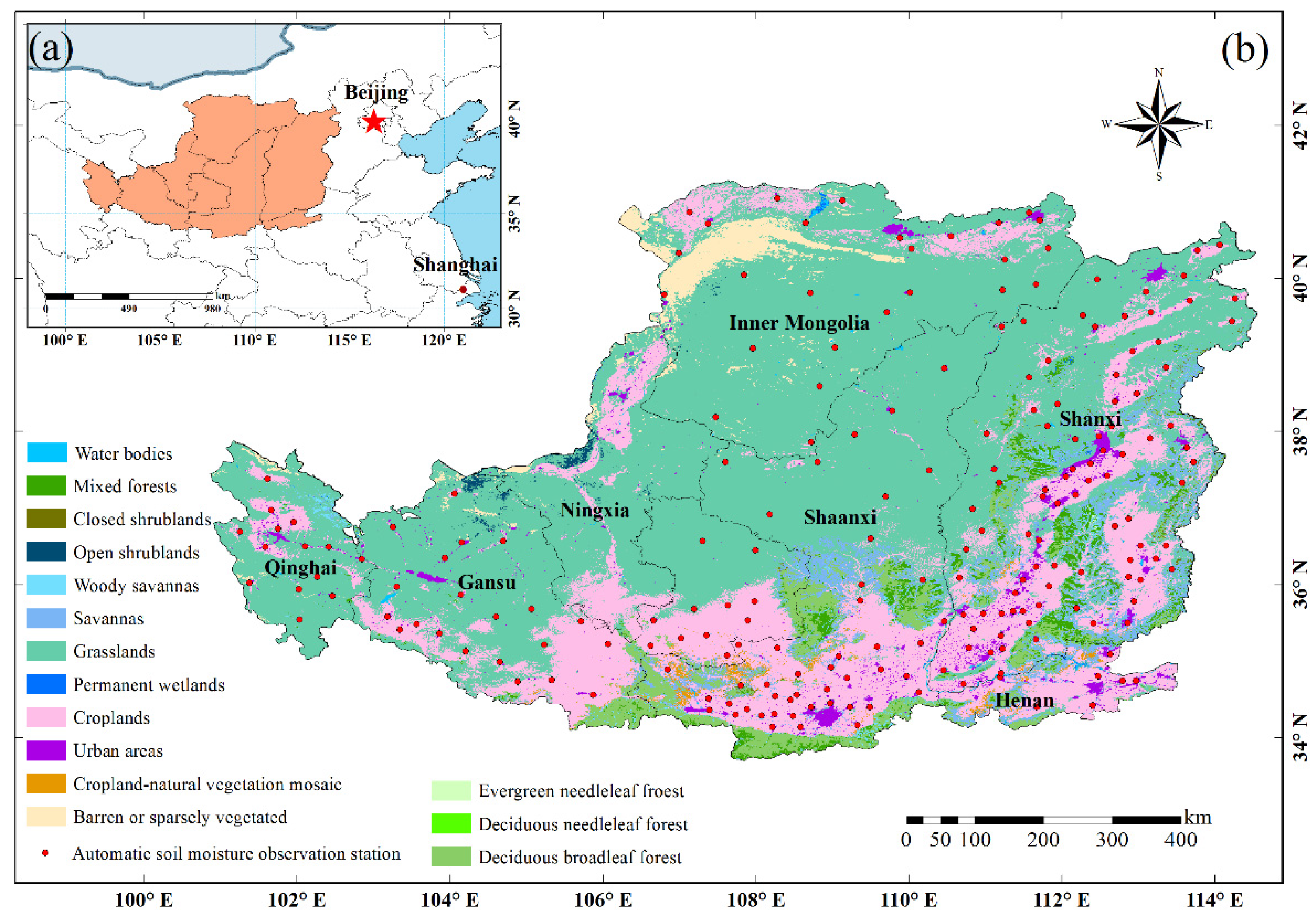

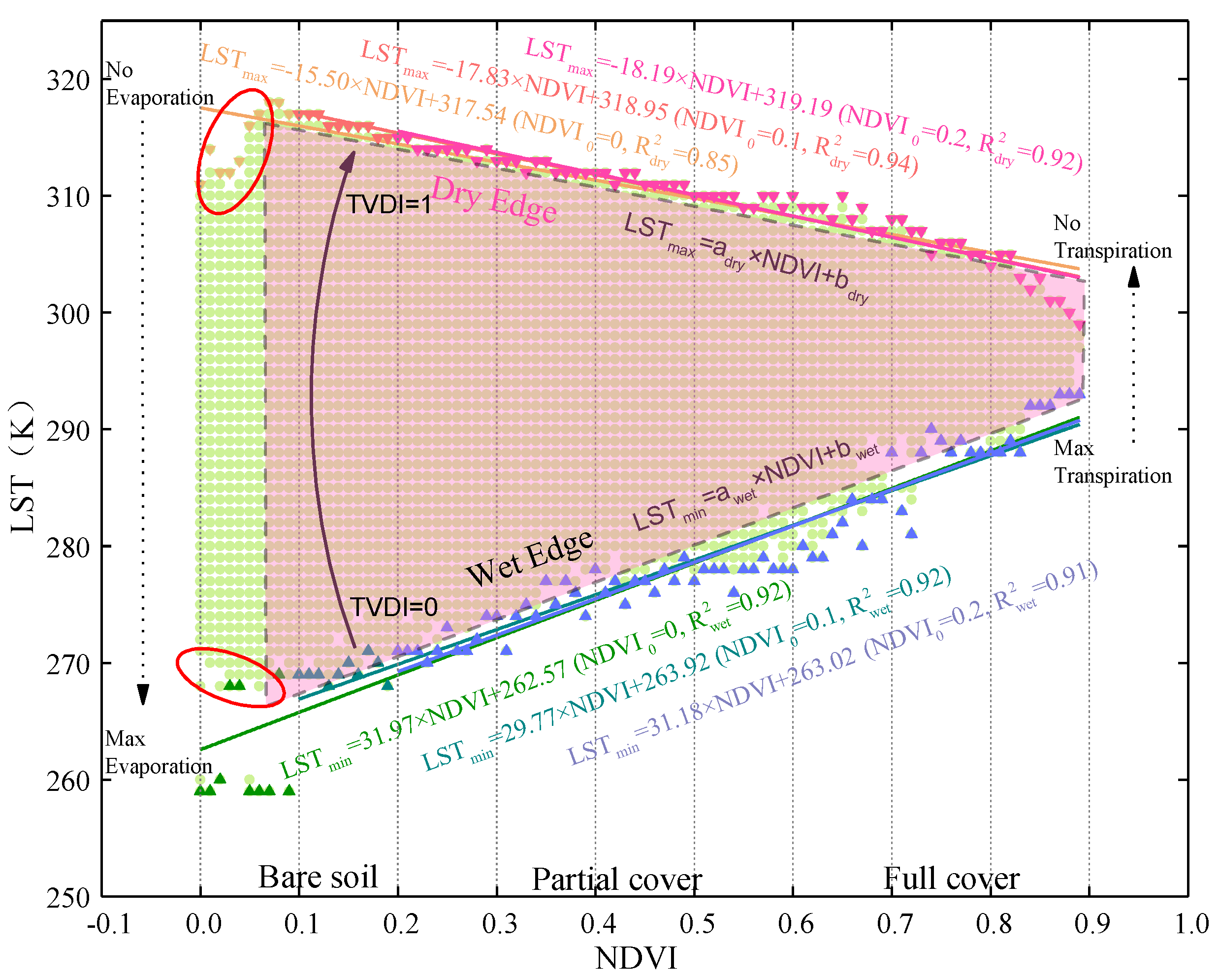
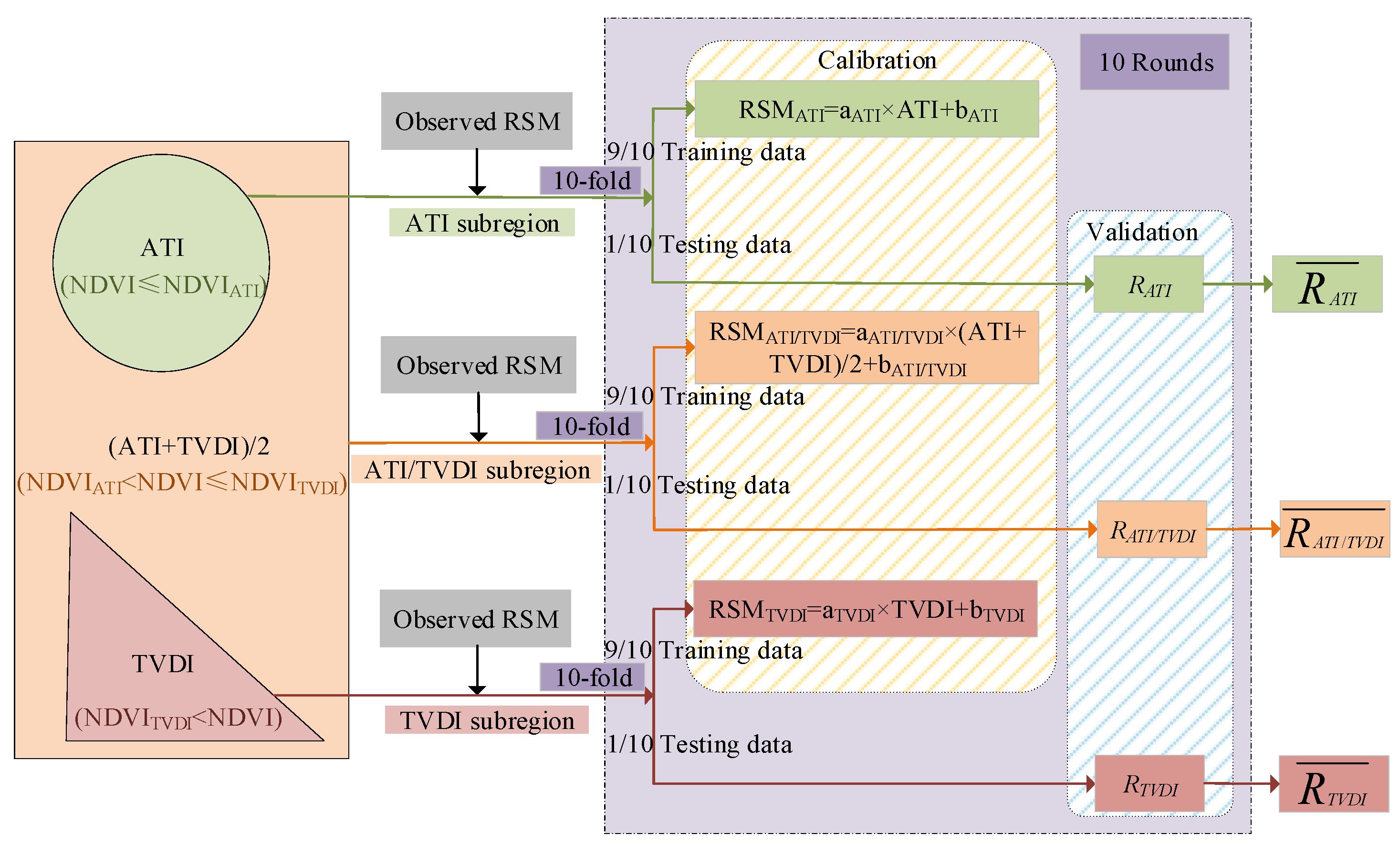

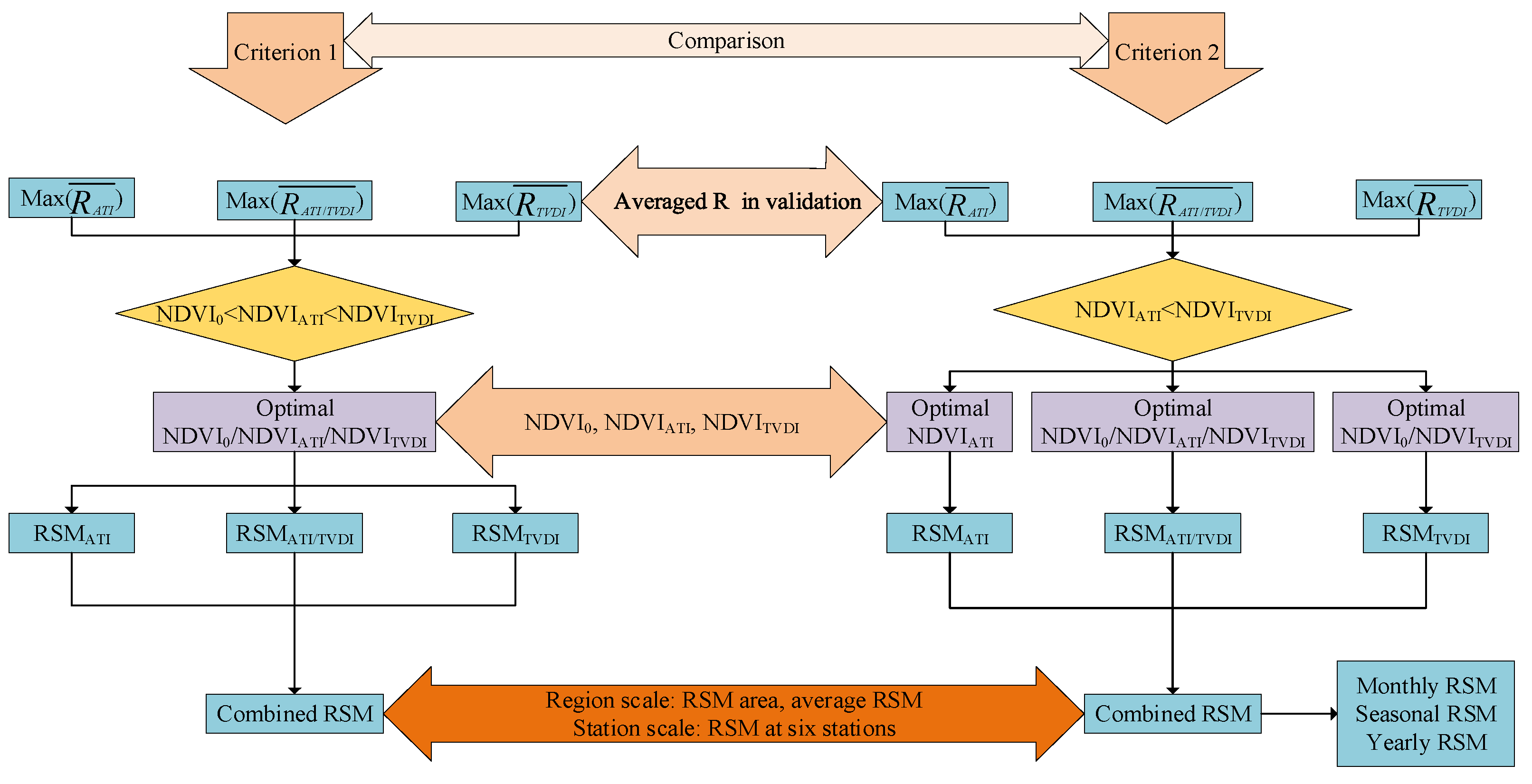

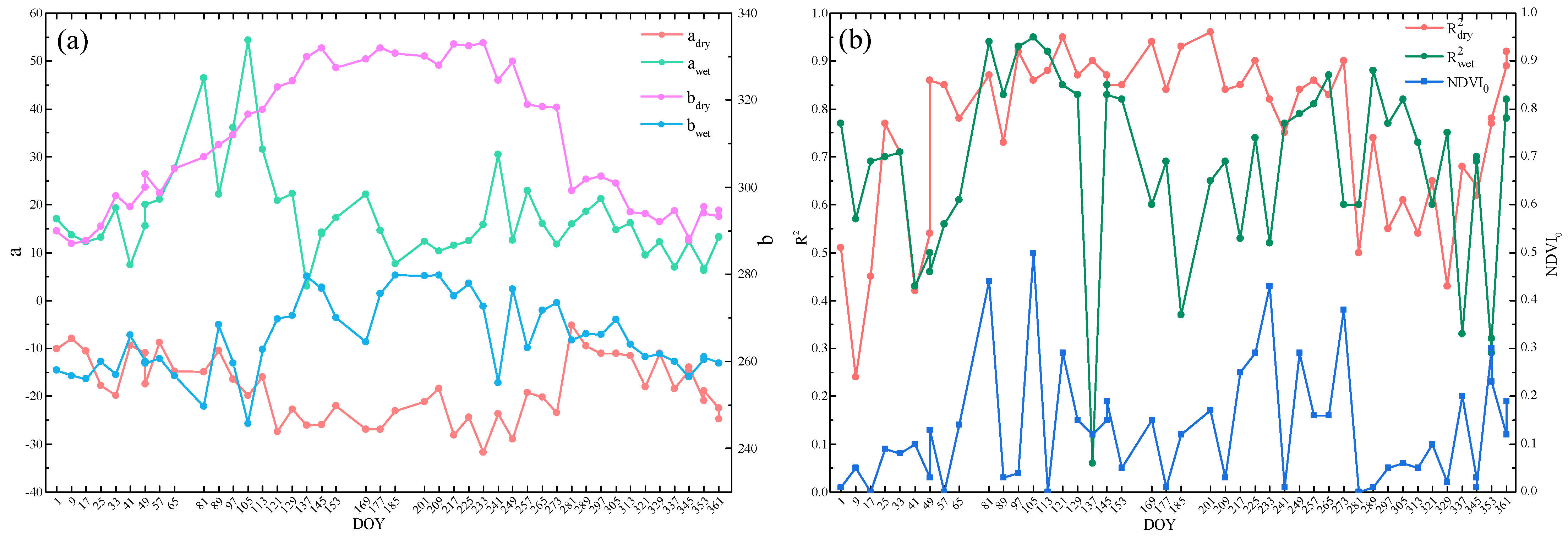
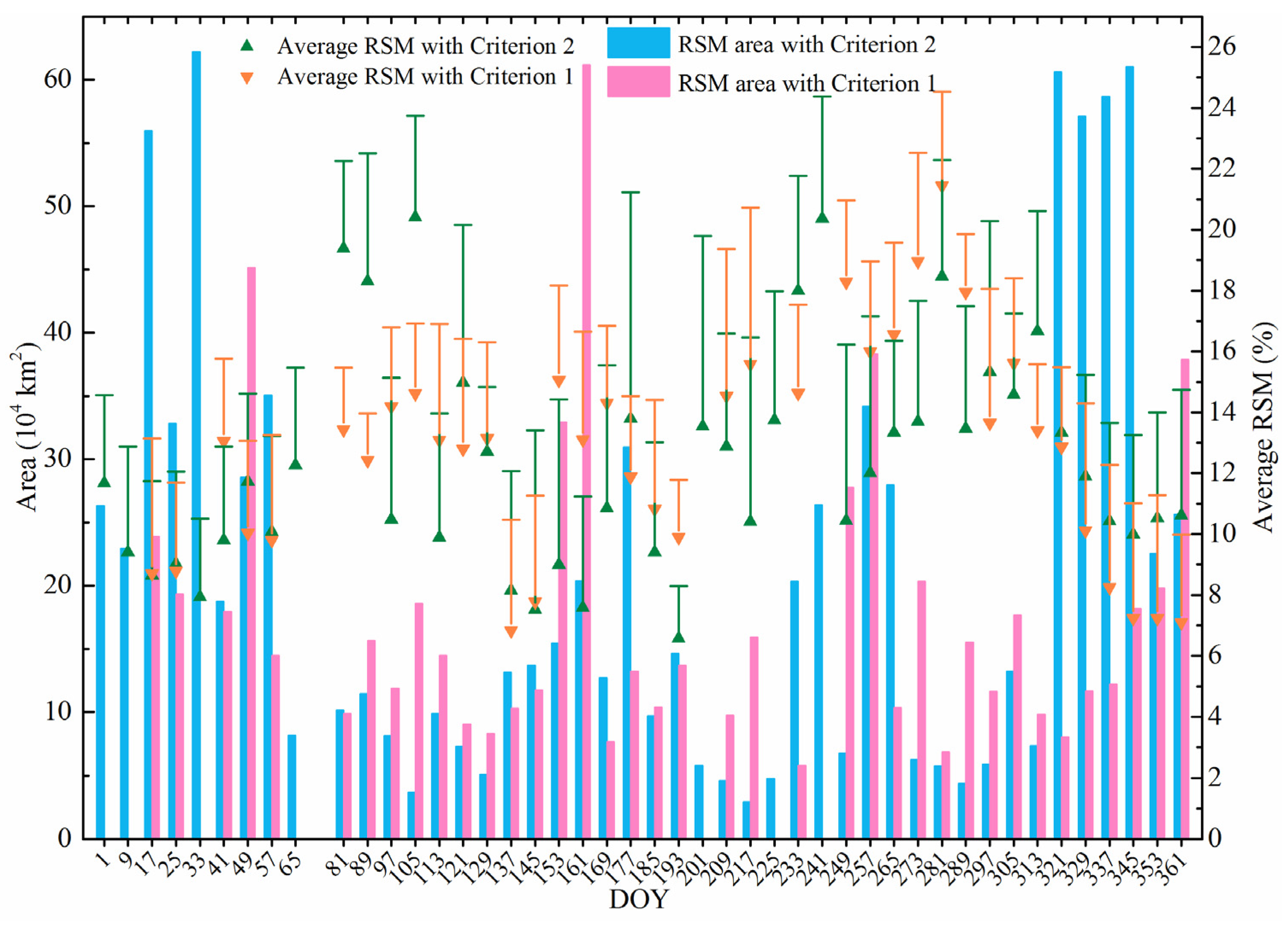

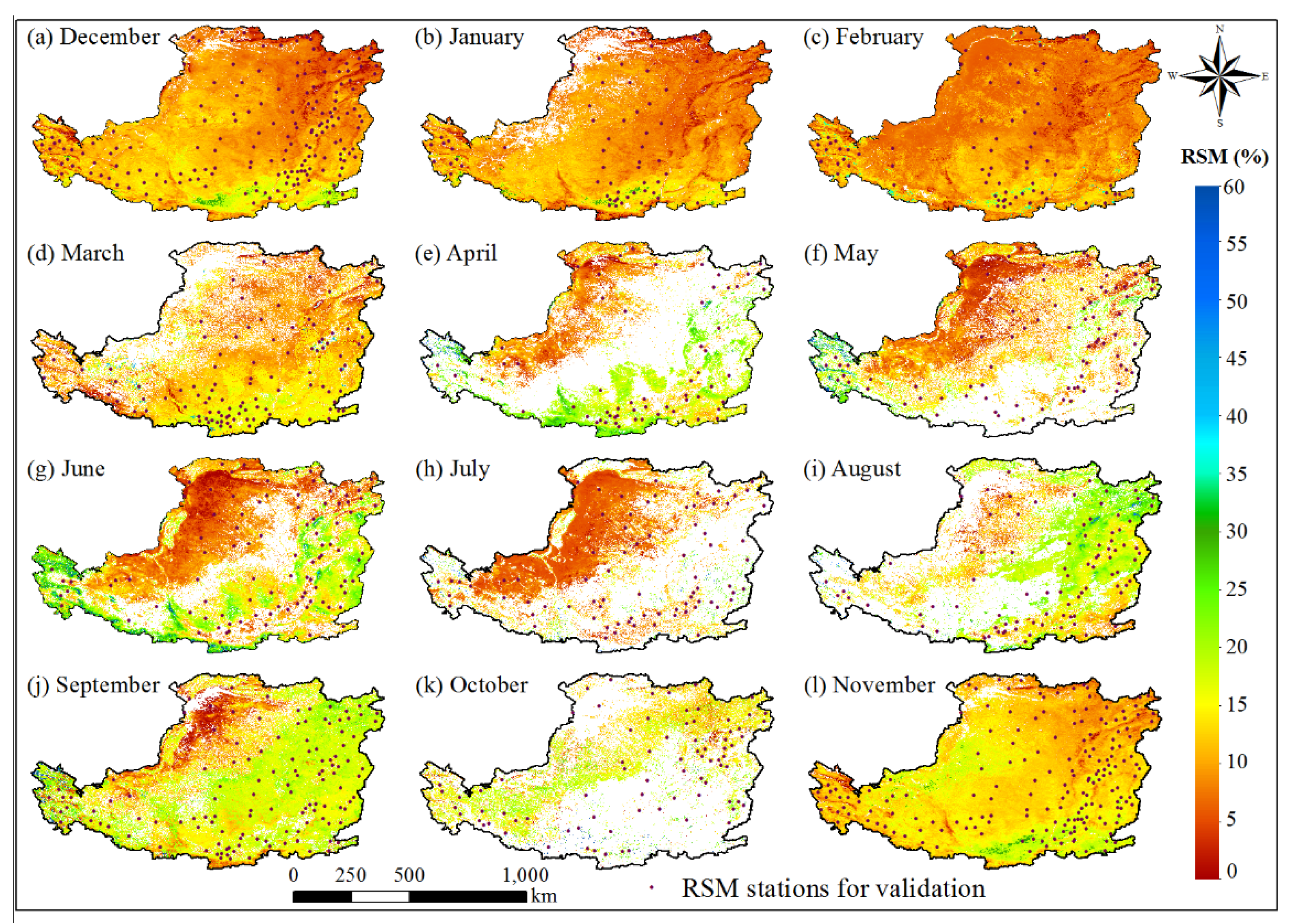
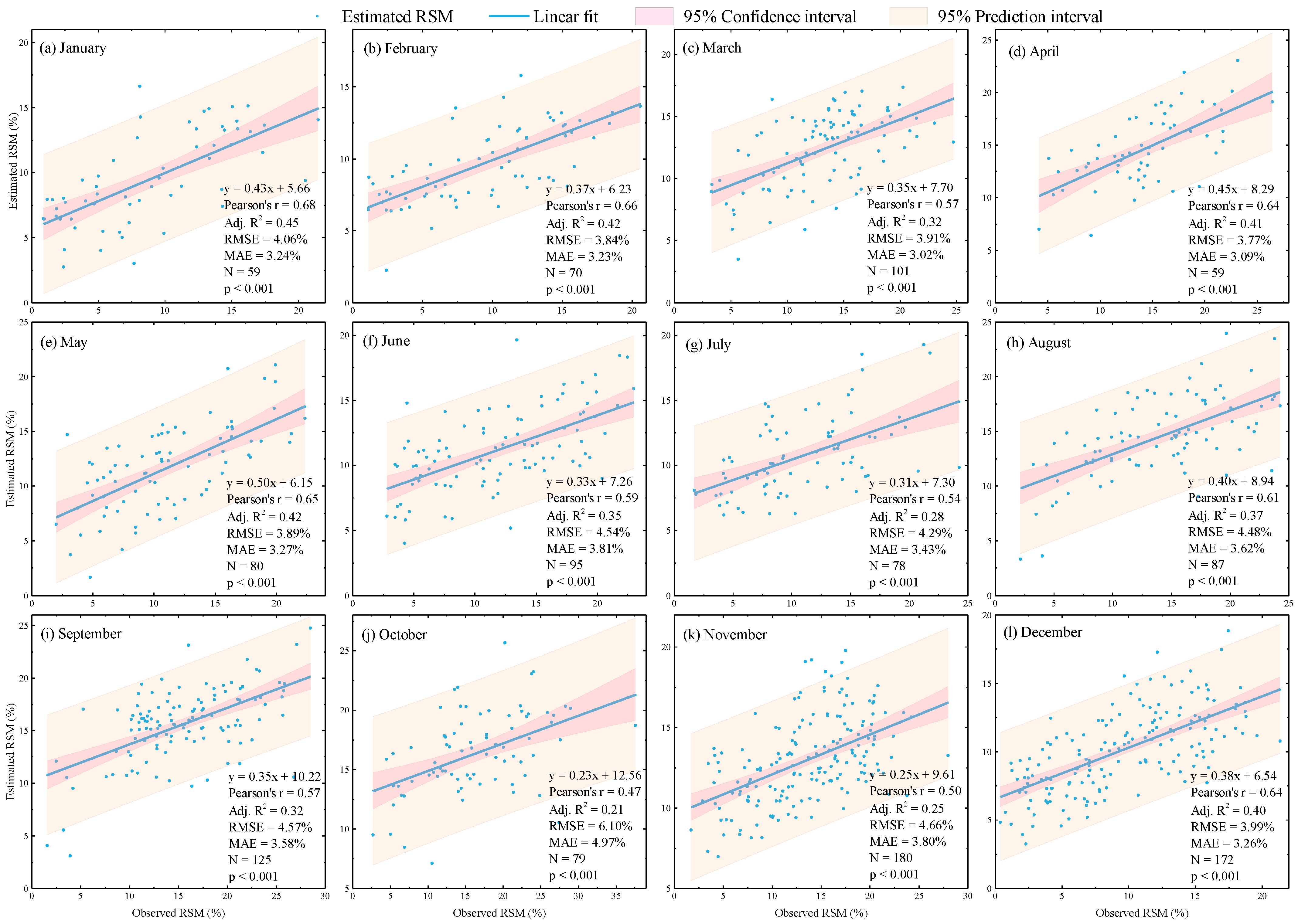
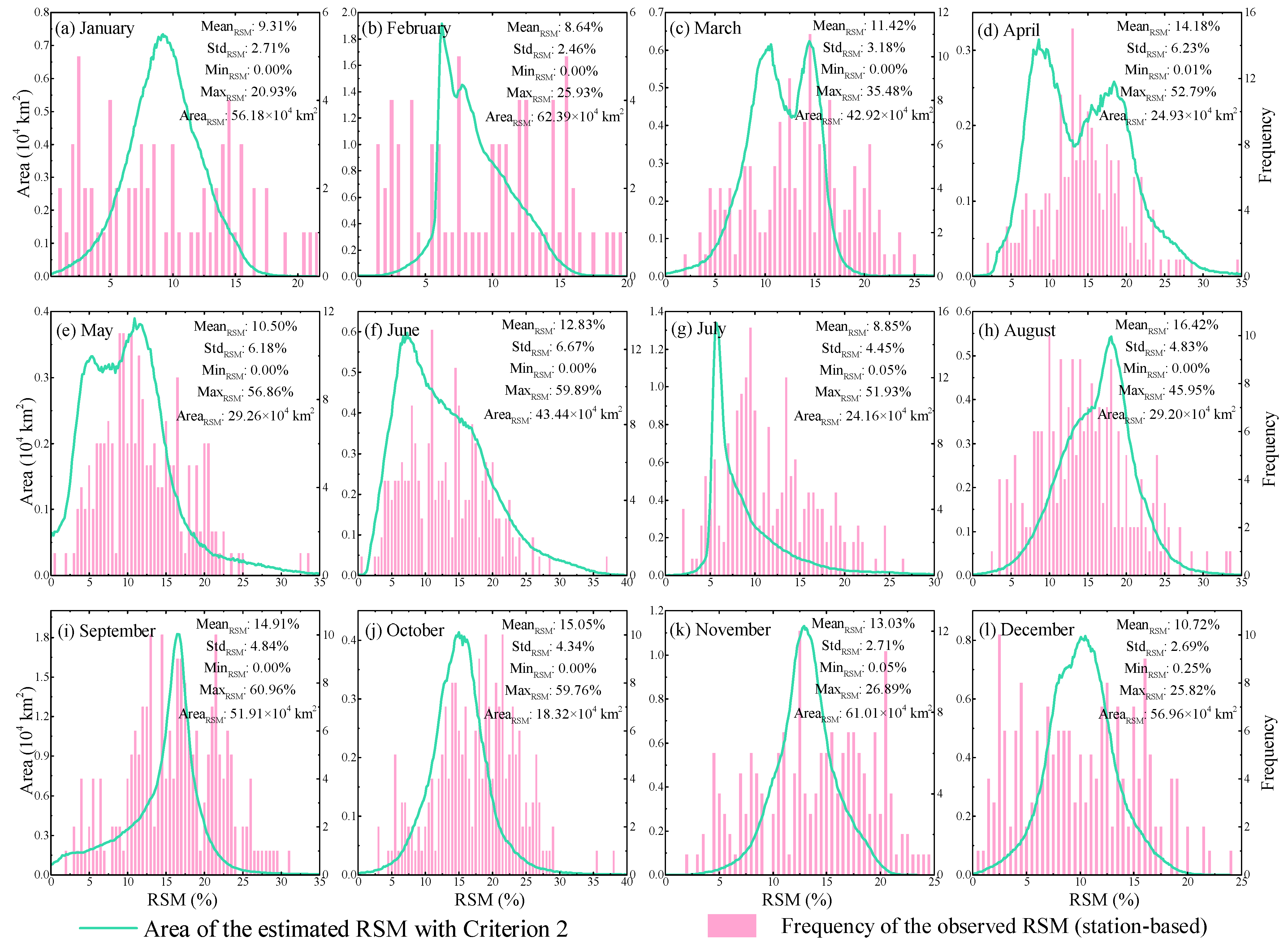
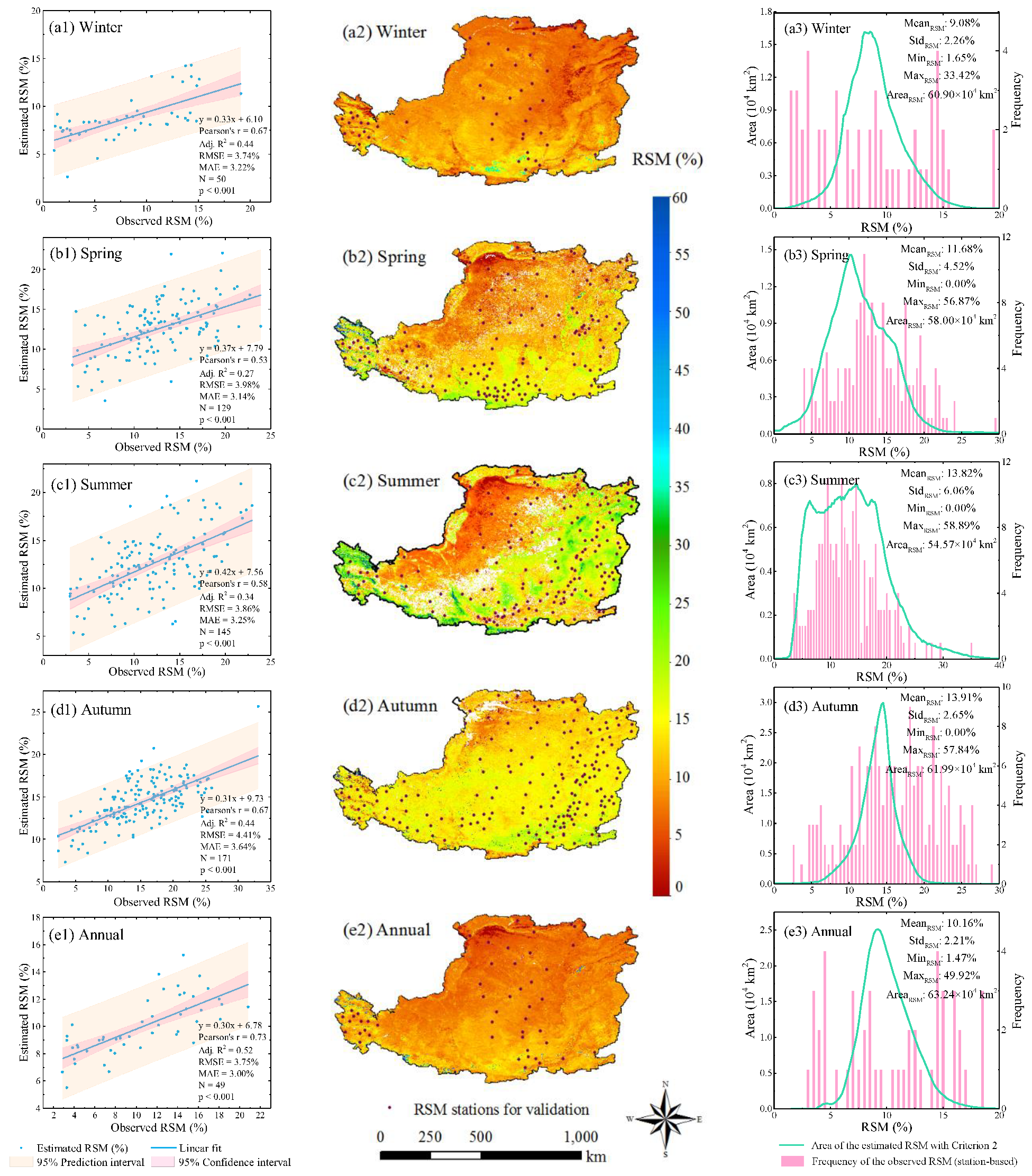
| Cases | Model Used 1 | Subregions | Optimal NDVI Thresholds 2 | Relationships 3 | If Overlaps |
|---|---|---|---|---|---|
| 1 | ATI | ATI | NDVIATI | - | No |
| 2 | ATI/TVDI | ATI/TVDI | NDVI0/NDVIATI/NDVITVDI | NDVIATI < NDVITVDI | No |
| 3 | TVDI | TVDI | NDVI0/NDVITVDI | - | No |
| 4 | ATI | ATI | NDVIATI | NDVIATI < NDVITVDI | No |
| TVDI | TVDI | NDVI0/NDVITVDI | NDVIATI ≥ NDVITVDI | Yes | |
| 5 | ATI | ATI | NDVIATI_a | NDVIATI_a <NDVIATI_j | No |
| ATI/TVDI | ATI/TVDI | NDVI0/NDVIATI_j/NDVITVDI | NDVIATI_a ≥ NDVIATI_j | Yes | |
| 6 | ATI/TVDI | ATI/TVDI | NDVI0_j/NDVIATI/NDVITVDI_j | NDVITVDI_j < NDVITVDI_t | No |
| TVDI | TVDI | NDVI0_t/NDVITVDI_t | NDVITVDI_j ≥ NDVITVDI_t | Yes | |
| 7 | ATI ATI/TVDI TVDI | ATI ATI/TVDI TVDI | NDVIATI_a NDVI0_j/NDVIATI_j/NDVITVDI_j NDVI0_t/NDVITVDI_t | NDVIATI_a < NDVIATI_j&NDVITVDI_j < NDVITVDI_t | No |
| NDVITVDI_t ≥ NDVIATI_a ≥ NDVIATI_j | Yes | ||||
| NDVITVDI_j ≥ NDVITVDI_t ≥ NDVIATI_a | Yes | ||||
| NDVIATI_a ≥ NDVITVDI_t | Yes |
| DOY | Month/Season | No. of Stations | Models | ± Std | Optimal NDVI0 | Optimal NDVIATI | Optimal NDVITVDI |
|---|---|---|---|---|---|---|---|
| 1 | Jan/Winter | 72 | ATI/TVDI | 0.50 ± 0.015 | 0.01 | 0.19 | 0.45 |
| 9 | Jan/Winter | 69 | ATI/TVDI | 0.78 ± 0.009 | 0.05 | 0.19 | 0.54 |
| 17 | Jan/Winter | 75 | ATI/TVDI | 0.62 ± 0.017 | 0.34 | 0.22 | 0.55 |
| TVDI | 0.56 ± 0.010 | 0.00 | 0.12 | ||||
| 25 | Jan/Winter | 74 | ATI/TVDI | 0.60 ± 0.012 | 0.09 | 0.15 | 0.44 |
| 33 | Feb/Winter | 75 | TVDI | 0.49 ± 0.015 | 0.08 | 0.14 | |
| ATI | 0.40 ± 0.021 | 0.16 | |||||
| ATI/TVDI | 0.78 ± 0.009 | 0.05 | 0.19 | 0.54 | |||
| 41 | Feb/Winter | 86 | ATI/TVDI | 0.57 ± 0.012 | 0.10 | 0.20 | 0.35 |
| 49 | Feb/Winter | 101 | ATI/TVDI | 0.51 ± 0.022 | 0.03 | 0.18 | 0.24 |
| TVDI | 0.43 ± 0.026 | 0.13 | 0.19 | ||||
| 57 | Mar/Spring | 157 | ATI/TVDI | 0.45 ± 0.019 | 0.00 | 0.19 | 0.27 |
| TVDI | 0.44 ± 0.012 | 0.07 | 0.17 | ||||
| 65 | Mar/Spring | 196 | ATI/TVDI | 0.43 ± 0.021 | 0.14 | 0.13 | 0.15 |
| 81 | Mar/Spring | 209 | ATI/TVDI | 0.44 ± 0.022 | 0.44 | 0.29 | 0.68 |
| 89 | Apr/Spring | 209 | ATI/TVDI | 0.55 ± 0.021 | 0.03 | 0.29 | 0.56 |
| 97 | Apr/Spring | 210 | ATI/TVDI | 0.38 ± 0.028 | 0.04 | 0.11 | 0.14 |
| 105 | Apr/Spring | 210 | ATI/TVDI | 0.31 ± 0.034 | 0.50 | 0.47 | 0.63 |
| 113 | Apr/Spring | 210 | ATI/TVDI | 0.30 ± 0.058 | 0.00 | 0.08 | 0.14 |
| 121 | May/Spring | 210 | ATI/TVDI | 0.35 ± 0.049 | 0.29 | 0.30 | 0.39 |
| 129 | May/Spring | 211 | ATI/TVDI | 0.25 ± 0.040 | 0.15 | 0.22 | 0.25 |
| 137 | May/Spring | 211 | ATI/TVDI | 0.40 ± 0.025 | 0.12 | 0.02 | 0.19 |
| 145 | May/Spring | 211 | ATI/TVDI | 0.63 ± 0.017 | 0.15 | 0.25 | 0.27 |
| ATI/TVDI | 0.61 ± 0.044 | 0.19 | 0.00 | 0.20 | |||
| 153 | Jun/Summer | 211 | ATI/TVDI | 0.51 ± 0.028 | 0.05 | 0.00 | 0.24 |
| 161 | Jun/Summer | 208 | ATI | 0.60 ± 0.010 | 0.28 | ||
| 169 | Jun/Summer | 211 | ATI/TVDI | 0.33 ± 0.019 | 0.10 | 0.22 | 0.34 |
| 177 | Jun/Summer | 211 | ATI/TVDI | 0.48 ± 0.028 | 0.01 | 0.07 | 0.24 |
| TVDI | 0.50 ± 0.026 | 0.01 | 0.57 | ||||
| 185 | Jul/Summer | 213 | ATI/TVDI | 0.48 ± 0.014 | 0.12 | 0.21 | 0.32 |
| 193 | Jul/Summer | 212 | ATI | 0.23 ± 0.036 | 0.27 | ||
| 201 | Jul/Summer | 212 | ATI/TVDI | 0.53 ± 0.020 | 0.17 | 0.50 | 0.59 |
| 209 | Aug/Summer | 212 | ATI/TVDI | 0.51 ± 0.019 | 0.03 | 0.26 | 0.32 |
| 217 | Aug/Summer | 213 | ATI/TVDI | 0.50 ± 0.037 | 0.25 | 0.29 | 0.33 |
| 225 | Aug/Summer | 213 | ATI/TVDI | 0.43 ± 0.021 | 0.29 | 0.32 | 0.38 |
| 233 | Aug/Summer | 213 | TVDI | 0.57 ± 0.017 | 0.43 | 0.55 | |
| 241 | Sep/Autumn | 213 | TVDI | 0.42 ± 0.024 | 0.01 | 0.52 | |
| 249 | Sep/Autumn | 213 | ATI/TVDI | 0.63 ± 0.010 | 0.29 | 0.22 | 0.32 |
| 257 | Sep/Autumn | 213 | ATI/TVDI | 0.52 ± 0.020 | 0.16 | 0.14 | 0.28 |
| ATI | 0.54 ± 0.033 | 0.26 | |||||
| TVDI | 0.51 ± 0.017 | 0.47 | 0.54 | ||||
| 265 | Sep/Autumn | 212 | ATI/TVDI | 0.49 ± 0.017 | 0.16 | 0.35 | 0.41 |
| TVDI | 0.52 ± 0.020 | 0.10 | 0.52 | ||||
| 273 | Oct/Autumn | 212 | ATI/TVDI | 0.32 ± 0.028 | 0.38 | 0.38 | 0.48 |
| 281 | Oct/Autumn | 212 | ATI/TVDI | 0.34 ± 0.038 | 0.00 | 0.33 | 0.39 |
| 289 | Oct/Autumn | 212 | ATI/TVDI | 0.36 ± 0.027 | 0.01 | 0.20 | 0.23 |
| 297 | Oct/Autumn | 212 | ATI/TVDI | 0.47 ± 0.015 | 0.05 | 0.21 | 0.25 |
| 305 | Nov/Autumn | 212 | ATI/TVDI | 0.47 ± 0.021 | 0.06 | 0.13 | 0.17 |
| ATI/TVDI | 0.44 ± 0.020 | 0.10 | 0.30 | 0.34 | |||
| 313 | Nov/Autumn | 213 | ATI/TVDI | 0.47 ± 0.022 | 0.05 | 0.15 | 0.18 |
| 321 | Nov/Autumn | 189 | TVDI | 0.33 ± 0.007 | 0.10 | 0.10 | |
| 329 | Nov/Autumn | 185 | ATI/TVDI | 0.71 ± 0.008 | 0.02 | 0.18 | 0.20 |
| TVDI | 0.59 ± 0.003 | 0.00 | 0.12 | ||||
| 337 | Dec/Winter | 185 | ATI/TVDI | 0.74 ± 0.009 | 0.20 | 0.24 | 0.31 |
| TVDI | 0.56 ± 0.005 | 0.01 | 0.11 | ||||
| 345 | Dec/Winter | 185 | ATI/TVDI | 0.66 ± 0.012 | 0.03 | 0.24 | 0.34 |
| TVDI | 0.58 ± 0.003 | 0.01 | 0.09 | ||||
| 353 | Dec/Winter | 185 | ATI/TVDI | 0.71 ± 0.010 | 0.30 | 0.23 | 0.38 |
| TVDI | 0.72 ± 0.009 | 0.23 | 0.23 | ||||
| 361 | Dec/Winter | 182 | ATI/TVDI | 0.82 ± 0.007 | 0.12 | 0.19 | 0.24 |
| TVDI | 0.76 ± 0.007 | 0.19 | 0.19 |
| Periods (DOY) | Criterion | Model | NDVIATI | NDVITVDI | ± Std | Area (104 km2) |
|---|---|---|---|---|---|---|
| 49 | 1 | ATI/TVDI | 0.14 | 0.64 | 0.38 ± 0.023 | 45.14 |
| 2 | ATI/TVDI | 0.18 | 0.24 | 0.51 ± 0.022 | 28.58 | |
| TVDI | 0.19 | 0.43 ± 0.026 | ||||
| 105 | 1 | ATI/TVDI | 0.21 | 0.35 | 0.25 ± 0.028 | 18.59 |
| 2 | ATI/TVDI | 0.47 | 0.63 | 0.31 ± 0.034 | 3.70 | |
| 153 | 1 | ATI | 0.34 | 0.41 | 0.35 ± 0.016 | 32.93 |
| ATI/TVDI | 0.50 ± 0.020 | |||||
| 2 | ATI/TVDI | 0.00 | 0.24 | 0.51 ± 0.028 | 15.43 | |
| 161 | 1 | ATI | 0.49 | 0.69 | 0.54 ± 0.008 | 61.17 |
| ATI/TVDI | 0.23 ± 0.044 | |||||
| TVDI | 0.34 ± 0.044 | |||||
| 2 | ATI | 0.28 | 0.60 ± 0.010 | 20.38 | ||
| 249 | 1 | ATI | 0.36 | 0.50 | 0.46 ± 0.049 | 27.78 |
| ATI/TVDI | 0.37 ± 0.040 | |||||
| 2 | ATI/TVDI | 0.22 | 0.32 | 0.63 ± 0.010 | 6.77 | |
| 289 | 1 | ATI/TVDI | 0.26 | 0.38 | 0.32 ± 0.018 | 15.51 |
| 2 | ATI/TVDI | 0.20 | 0.23 | 0.36 ± 0.027 | 4.37 |
| Station | Longitude (°N) | Latitude (°E) | Elevation (m) | Land cover | Total Precipitation in 2017 (mm) |
|---|---|---|---|---|---|
| 53,553 | 111.22 | 39.85 | 1221.40 | Grassland | 410 |
| 53,771 | 112.05 | 37.41 | 750.00 | Cropland | 616 |
| 53,845 | 109.50 | 36.60 | 1180.50 | Urban area | 750.8 |
| 53,857 | 110.18 | 36.06 | 110.18 | Cropland | 549 |
| 57,031 | 108.55 | 34.83 | 1012.70 | Cropland | 662 |
| 57,048 | 108.72 | 34.40 | 472.80 | Cropland | 708 |
Publisher’s Note: MDPI stays neutral with regard to jurisdictional claims in published maps and institutional affiliations. |
© 2021 by the authors. Licensee MDPI, Basel, Switzerland. This article is an open access article distributed under the terms and conditions of the Creative Commons Attribution (CC BY) license (http://creativecommons.org/licenses/by/4.0/).
Share and Cite
Yuan, L.; Li, L.; Zhang, T.; Chen, L.; Zhao, J.; Liu, W.; Cheng, L.; Hu, S.; Yang, L.; Wen, M. Improving Soil Moisture Estimation by Identification of NDVI Thresholds Optimization: An Application to the Chinese Loess Plateau. Remote Sens. 2021, 13, 589. https://doi.org/10.3390/rs13040589
Yuan L, Li L, Zhang T, Chen L, Zhao J, Liu W, Cheng L, Hu S, Yang L, Wen M. Improving Soil Moisture Estimation by Identification of NDVI Thresholds Optimization: An Application to the Chinese Loess Plateau. Remote Sensing. 2021; 13(4):589. https://doi.org/10.3390/rs13040589
Chicago/Turabian StyleYuan, Lina, Long Li, Ting Zhang, Longqian Chen, Jianlin Zhao, Weiqiang Liu, Liang Cheng, Sai Hu, Longhua Yang, and Mingxin Wen. 2021. "Improving Soil Moisture Estimation by Identification of NDVI Thresholds Optimization: An Application to the Chinese Loess Plateau" Remote Sensing 13, no. 4: 589. https://doi.org/10.3390/rs13040589
APA StyleYuan, L., Li, L., Zhang, T., Chen, L., Zhao, J., Liu, W., Cheng, L., Hu, S., Yang, L., & Wen, M. (2021). Improving Soil Moisture Estimation by Identification of NDVI Thresholds Optimization: An Application to the Chinese Loess Plateau. Remote Sensing, 13(4), 589. https://doi.org/10.3390/rs13040589








